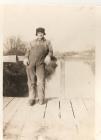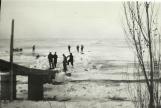2
When the last boat of the season left with the last Island visitors, the Island families got down to work.3
Friends and neighboursCirca 1941
Pelee Island, Ontario
 Credits:
Credits:Essex Kent Mennonite Historical Association
4
It was time to get ready for Christmas: new outfits needed to be sewn, gifts were ordered from the Eaton's catalogue, and the house was cleaned from top to bottom. Christmas cookies were baked and stored in large containers in the unheated back entrance.5
Erna Fast waiting for a ride to school with the Anglican Church pastorCirca 1944
Pelee Island, Ontario
 Credits:
Credits:Essex Kent Mennonite Historical Association
6
Shortly after Christmas, and often before the New Year, the Island had what was called "Case weather." The tobacco needed to be stripped and baled. This job took all winter. First the twine, then paper, was placed in the bottomless box; both needed to hang well over the sides. Next the tobacco was trampled down, covered with the paper, and tied with the string. These so-called bale ends remained open. It was always cold.7
The McKee farm, share-cropped by Jake GossenCirca 1939
Pelee Island, Ontario
 Credits:
Credits:Essex Kent Mennonite Historical Association
8
Later, families had a separate, heated strip room in the barn. Sometimes the children were expected to help, and as a result, they missed many days of school. By the mid-1930s, the heavy Black and Burley tobacco was no longer in demand.9
Jake Gossen in winterCirca 1930
Pelee Island, Ontario
 Credits:
Credits:Essex Kent Mennonite Historical Association
10
Once the lake had frozen over, it was time to cut ice blocks for use during the summer months.12
The Island's men were kept busy for many days cutting and hauling ice blocks to the South End and North End ice houses.13
Hauling ice blocksCirca 1930
Pelee Island, Ontario
 Credits:
Credits:Essex Kent Mennonite Historical Association
14
During the summer months, these ice blocks were picked up about once a week for the family's ice box.There was no electricity on the Island until the late 1940s. Ice storage was a necessity for summer use. In the next picture, the horses are ready to haul ice blocks on a roller system created by a series of logs.

